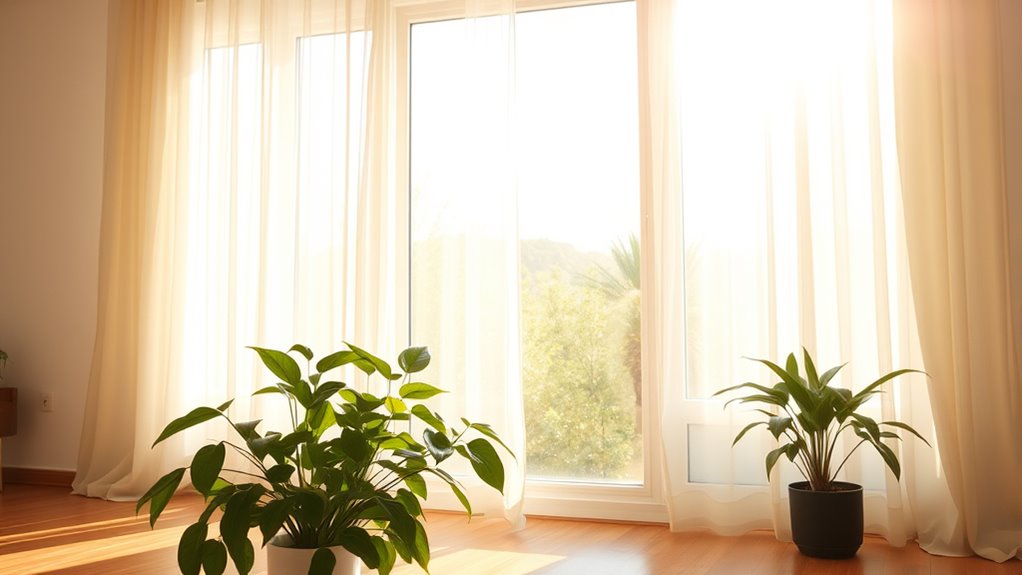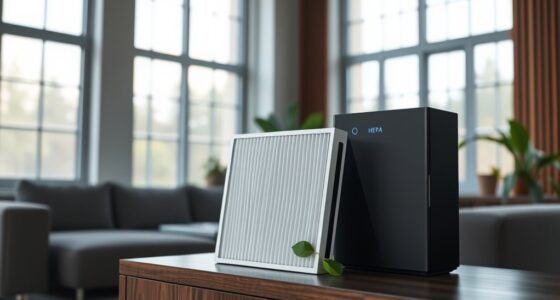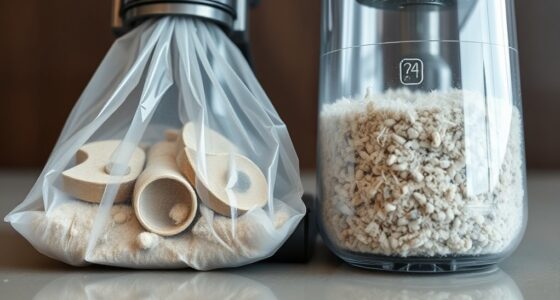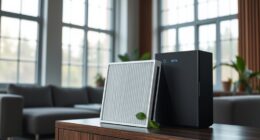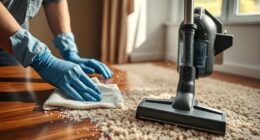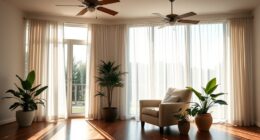To keep your home’s air fresh and healthy, aim for about 0.35 to 0.5 air changes per hour, meaning you should air out your space roughly every 2 to 3 hours. Regularly ventilating helps remove pollutants like dust, pet dander, and chemicals. Using mechanical systems or natural ventilation guarantees consistent airflow. Understanding these rates helps you optimize your ventilation practices for a healthier indoor environment—keep exploring to learn more about maintaining ideal air quality.
Key Takeaways
- Aim for 0.35 to 0.5 air changes per hour, replacing indoor air every 2-3 hours.
- Use mechanical ventilation systems like HRVs or ERVs for consistent airflow.
- Ventilate naturally during activities like cooking or cleaning to reduce indoor pollutants.
- Regularly evaluate and adjust airflow based on occupancy and activities.
- Properly maintain ventilation systems to ensure effective air exchange and indoor air quality.
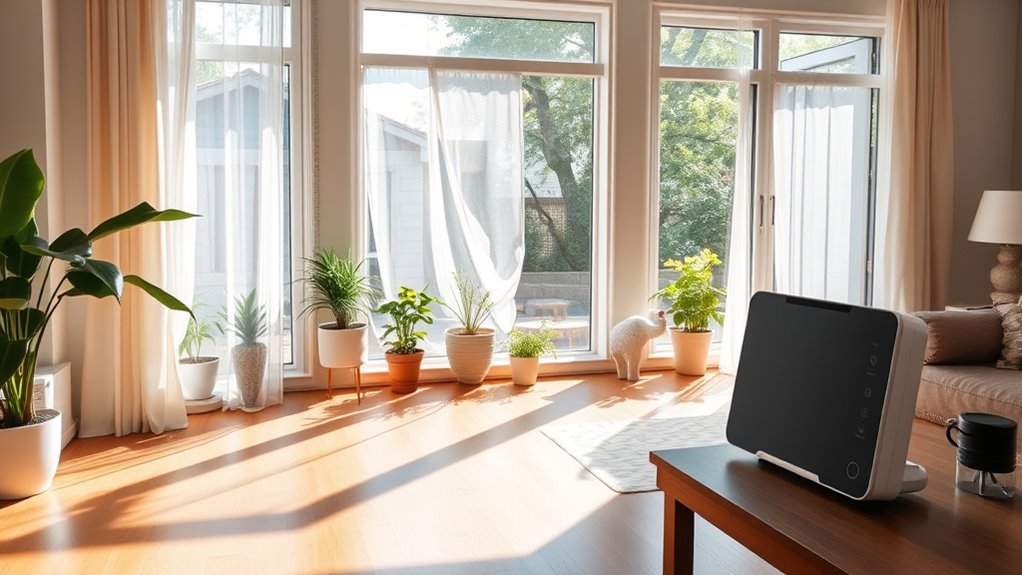
Have you ever wondered how the air in your home stays fresh and safe? The secret lies in proper air exchange rates, which determine how often you should air out your space. When you understand these rates, you can maintain a healthier indoor environment by effectively managing indoor pollutant removal. This process involves more than just opening windows; it requires a thoughtful approach to ventilation system design that ensures pollutants like dust, pet dander, mold spores, and indoor chemicals are efficiently removed.
A well-designed ventilation system helps keep indoor air quality high by controlling how frequently fresh air enters and stale air exits. The key is finding the right balance—too little ventilation allows pollutants to accumulate, while excessive airing can waste energy and cause discomfort. Generally, the recommended air change rate for most homes is about 0.35 to 0.5 air changes per hour, meaning the entire volume of indoor air is replaced roughly every two to three hours. However, this can vary depending on factors like occupancy, activities, and local air quality standards.
When considering ventilation system design, it’s important to incorporate features that support consistent air exchange without sacrificing energy efficiency. Mechanical ventilation systems, such as HRVs (heat recovery ventilators) or ERVs (energy recovery ventilators), are especially effective because they control airflow and filter incoming air, improving indoor pollutant removal. These systems work continuously to bring in fresh air and expel stale air, reducing the need for manual airing and maintaining steady air exchange rates. If you rely on natural ventilation, like opening windows, it’s best to do so regularly, especially during times when indoor pollutant levels are higher—cooking, cleaning, or after activities like painting or sanding.
Proper ventilation system design also considers the placement of air intakes and exhausts to prevent cross-contamination from outdoor pollutants or indoor sources. Good design ensures a steady, controlled flow of air that replaces contaminated indoor air with filtered, fresh outdoor air at appropriate intervals. This not only improves indoor air quality but also enhances energy efficiency by reducing the workload on heating and cooling systems. Additionally, understanding air exchange rates can help you optimize your home’s ventilation to better match your specific needs and conditions.
Effective ventilation design balances intake and exhaust to optimize air quality and energy efficiency.
Ultimately, understanding how often to air out your home depends on your specific living situation, but integrating a well-thought-out ventilation system can make a significant difference. It guarantees consistent indoor pollutant removal, keeps your air fresh, and promotes a healthier living environment. Regularly evaluating your ventilation needs and maintaining your system ensures you’re providing yourself and your family with the clean, safe air you deserve.
Frequently Asked Questions
How Does Outdoor Air Quality Affect Indoor Air Exchange Needs?
Outdoor air quality directly impacts your indoor air exchange needs. If outdoor pollution levels are high, you might want to limit opening windows and rely more on air filtration systems to keep pollutants out. Conversely, when outdoor air is cleaner, airing out your home more frequently helps refresh indoor air. Monitoring outdoor air quality helps you decide when to ventilate and when to enhance filtration, ensuring healthier indoor air.
What Are the Signs Indicating My Home Needs More Ventilation?
Imagine your home as a living organism, craving fresh air to thrive. If you notice humidity buildup or stale odors lingering, it’s a clear sign you need more ventilation. These signs indicate poor airflow, which can lead to mold, allergies, and discomfort. Don’t ignore these cues—open windows, use exhaust fans, or upgrade your ventilation system to bring in the fresh air your home needs to stay healthy and comfortable.
Can Air Exchange Rates Vary Seasonally or by Weather?
Yes, air exchange rates can vary seasonally and with weather impact. During colder months, you might open windows less to keep heat in, reducing ventilation. Conversely, in milder weather, you tend to air out your home more often, increasing exchange rates. Rain, wind, and humidity also influence how much fresh air circulates, so it’s essential to adjust your ventilation habits based on seasonal variation and weather conditions to maintain good indoor air quality.
How Do Different Household Activities Impact Optimal Air Exchange?
Different household activities, like cooking, cleaning, or smoking, increase indoor pollutants, requiring more frequent ventilation. To maintain good air quality, you should adjust your ventilation strategies accordingly, opening windows or using exhaust fans during and after these activities. This helps remove pollutants faster and keeps indoor air fresh. Monitoring activity levels helps you determine when to air out your home more often, ensuring a healthier environment.
Are There Health Risks Associated With Over-Ventilating a Home?
Over-ventilating your home can lead to issues like ventilation fatigue and increased energy bills, but health risks are generally minimal if you don’t go to extremes. Studies show indoor pollutants can be diminished with proper airflow, yet excessive airing might introduce outdoor allergens or drafts. Be mindful of balancing fresh air with control to avoid discomfort. Moderation ensures you improve indoor air quality without risking unnecessary exposure or fatigue.
Conclusion
Remember, a well-ventilated home is like a gust of fresh air for your health. Regularly airing out your space helps remove pollutants and keeps the air invigorating. Don’t wait until it’s too late—think of it as an ounce of prevention worth a pound of cure. By maintaining good air exchange rates, you create a healthier environment for you and your loved ones. After all, a gust of fresh air is priceless.
